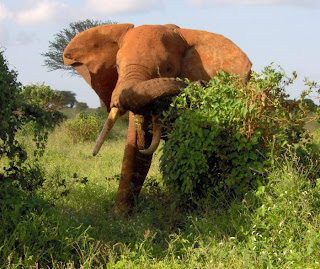True Wild Life | African Bush Elephant | The African bush elephant is the largest known land mammal on Earth, with male African bush elephants reaching over 3.5 metres in height and the female African bush elephants around 3 metres. The African bush elephant mainly lives in central and southern Africa in nomadic herds that wander the plains and grasslands of Africa grazing for food and searching for waterholes. The African bush elephant has no natural predators to threaten its survival, mainly due to the African bush elephant's sheer size. African bush elephants can be seen co-inhabiting in the African wilderness with other large mammals and birds, relatively peacefully.
Sadly, due to an increase of outside interest in Africa and its exotic wonders, the African bush elephant population took a devastating decline towards extinction. In 1989 a worldwide elephant ivory hunting ban fell into place, meaning that the African bush elephant population has fortunately begun to recover. The tusks of an African bush elephant can grow to nearly 2.5 meters long and generally weigh between 50 and 100 pounds, which is about the same as a small adult human. The African bush elephant uses these immense tusks for digging for roots in the ground and to strip the bark of trees. The African bush elephant also uses its tusks to defend itself from predators such as lions, and to fight with other male African bush elephants during the mating season.There are thought to be two species of the African elephant which are the African bush elephant and the African forest elephant. Although these two elephant species are very similar, the African bush elephant is considered to be bigger in size than the African forest elephant. The African forest elephant is thought to also have rounder ears and straighter tusks than the African bush elephant, and it has been also noted that the African bush elephant and the African forest elephant have a different number of toe nails.
African bush elephants have four molar teeth each weighing about 5.0 kg and measuring about 12 inches long. As the front pair of molars in the mouth of the African bush elephant wear down and drop out in pieces, the back pair shift forward and two new molars emerge in the back of the African bush elephant's mouth. African bush elephants replace their teeth six times during their lives but when the African bush elephant is about 40 to 60 years old, the African bush elephant no longer has teeth and will likely die of starvation, which is sadly a common cause of death in the African wilderness.
African bush elephants have four molar teeth each weighing about 5.0 kg and measuring about 12 inches long. As the front pair of molars in the mouth of the African bush elephant wear down and drop out in pieces, the back pair shift forward and two new molars emerge in the back of the African bush elephant's mouth. African bush elephants replace their teeth six times during their lives but when the African bush elephant is about 40 to 60 years old, the African bush elephant no longer has teeth and will likely die of starvation, which is sadly a common cause of death in the African wilderness.
Females African bush elephants reach sexual maturity (are able to reproduce) after 10 or 11 years, and male African bush elephants often don't reach sexual maturity until they are nearly 20 years old. After a gestation period of up to 2 years, the female African bush elephant gives birth to a single calf (twins have been known but are extremely rare). The African bush elephant calf is nursed for 2 years and will remain with the herd until it is old enough to support itself. It is at this point that the tusks of the African bush elephant calf will be starting to grow.
Today, although recovering, African bush elephant populations are still threatened from increasing levels of illegal poaching and habitat destruction. Deforestation in the African bush elephant's territory means that the African bush elephants lose both their food and shelter making them more vulnerable in the wild. African bush elephants are also constantly threatened by poachers hunting the elephants for their ivory tusks.
Today, although recovering, African bush elephant populations are still threatened from increasing levels of illegal poaching and habitat destruction. Deforestation in the African bush elephant's territory means that the African bush elephants lose both their food and shelter making them more vulnerable in the wild. African bush elephants are also constantly threatened by poachers hunting the elephants for their ivory tusks.




Tidak ada komentar:
Posting Komentar